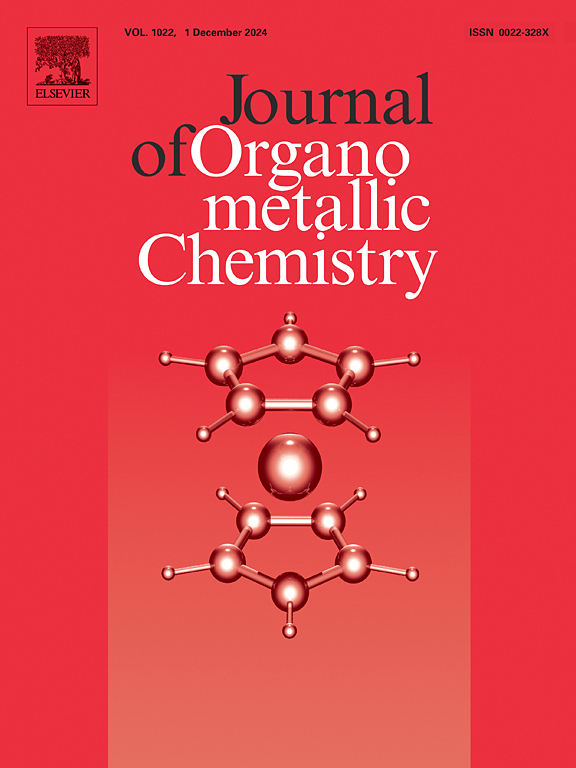Graphene oxide decorated N-heterocyclic carbene–nickel complex with pendant caffeine for C–H arylation of benzoxazole
IF 2.1
3区 化学
Q3 CHEMISTRY, INORGANIC & NUCLEAR
引用次数: 0
Abstract
Graphene oxide supported N-heterocyclic carbene nickel complex GO![]() Caff-NHC@Ni has been prepared by covalent binding of caffeine in the matrix of functionalized graphene oxide (GO) followed by complexation using Ni (II) acetate. [GO
Caff-NHC@Ni has been prepared by covalent binding of caffeine in the matrix of functionalized graphene oxide (GO) followed by complexation using Ni (II) acetate. [GO![]() Caff-NHC@Ni] has been characterized by various analytical techniques, including Fourier transform infrared (FT-IR) spectroscopy, energy-dispersive X-ray (EDX) spectroscopy, transmission electron microscopy (TEM), scanning electron microscopy (SEM), Brunauer-Emmett-Teller (BET) analysis, X-ray diffraction (XRD), thermogravimetric analysis (TGA), and X-ray photoelectron spectroscopy (XPS) analysis. [GO
Caff-NHC@Ni] has been characterized by various analytical techniques, including Fourier transform infrared (FT-IR) spectroscopy, energy-dispersive X-ray (EDX) spectroscopy, transmission electron microscopy (TEM), scanning electron microscopy (SEM), Brunauer-Emmett-Teller (BET) analysis, X-ray diffraction (XRD), thermogravimetric analysis (TGA), and X-ray photoelectron spectroscopy (XPS) analysis. [GO![]() Caff-NHC@Ni] exhibited notable efficiency as a heterogeneous catalyst in facilitating the C
Caff-NHC@Ni] exhibited notable efficiency as a heterogeneous catalyst in facilitating the C![]() H arylation reaction between benzoxazole and aryl boronic acids. Remarkably, recycling experiments indicated that the complex consistently maintained its catalytic activity over multiple cycles, exhibiting its ability to be effectively utilized up to six times without a significant decline in its catalytic performance.
H arylation reaction between benzoxazole and aryl boronic acids. Remarkably, recycling experiments indicated that the complex consistently maintained its catalytic activity over multiple cycles, exhibiting its ability to be effectively utilized up to six times without a significant decline in its catalytic performance.
Advantages:
- •Efficiency: High catalytic performance due to the innovative design integrating graphene oxide and N-heterocyclic carbene ligands.
- •Sustainability: Offers a sustainable alternative to traditional methods, aligning with green chemistry principles.
- •Economic Viability: Reduces the need for frequent catalyst replacement, lowering costs.
- •Environmental Impact: Minimizes environmental impact through the use of non-hazardous solvents and robust catalyst design.
- •Versatility: Potential for application in various organic transformations, promoting greener and more sustainable chemical manufacturing.
- •Practicality: Short reaction times and simple work-up procedures enhance the practicality and efficiency of the methodology.
含咖啡因的氧化石墨烯修饰n -杂环碳-镍配合物,用于苯并恶唑的碳氢基化
通过在官能化氧化石墨烯(GO)基体中与咖啡因共价结合,再与醋酸镍络合,制备了氧化石墨烯负载的n -杂环碳烯镍配合物GOCaff-NHC@Ni。[GOCaff-NHC@Ni]已经通过各种分析技术进行了表征,包括傅里叶变换红外(FT-IR)光谱、能量色散x射线(EDX)光谱、透射电子显微镜(TEM)、扫描电子显微镜(SEM)、布鲁诺尔-埃米特-泰勒(BET)分析、x射线衍射(XRD)、热重分析(TGA)和x射线光电子能谱(XPS)分析。[GOCaff-NHC@Ni]在促进苯并恶唑和芳基硼酸之间的CH芳基化反应中表现出显著的效率。值得注意的是,回收实验表明,该配合物在多次循环中始终保持其催化活性,表明其能够有效利用多达六次而不会显著降低其催化性能。•效率:由于集成了氧化石墨烯和n -杂环碳配体的创新设计,具有很高的催化性能。•可持续性:提供传统方法的可持续替代方案,符合绿色化学原则。经济可行性:减少了频繁更换催化剂的需求,降低了成本。•环境影响:通过使用无害溶剂和坚固的催化剂设计,最大限度地减少对环境的影响。•多功能性:可应用于各种有机转化,促进更环保、更可持续的化工生产。•实用性:反应时间短,操作步骤简单,提高了方法的实用性和效率。
本文章由计算机程序翻译,如有差异,请以英文原文为准。
求助全文
约1分钟内获得全文
求助全文
来源期刊

Journal of Organometallic Chemistry
化学-无机化学与核化学
CiteScore
4.40
自引率
8.70%
发文量
221
审稿时长
36 days
期刊介绍:
The Journal of Organometallic Chemistry targets original papers dealing with theoretical aspects, structural chemistry, synthesis, physical and chemical properties (including reaction mechanisms), and practical applications of organometallic compounds.
Organometallic compounds are defined as compounds that contain metal - carbon bonds. The term metal includes all alkali and alkaline earth metals, all transition metals and the lanthanides and actinides in the Periodic Table. Metalloids including the elements in Group 13 and the heavier members of the Groups 14 - 16 are also included. The term chemistry includes syntheses, characterizations and reaction chemistry of all such compounds. Research reports based on use of organometallic complexes in bioorganometallic chemistry, medicine, material sciences, homogeneous catalysis and energy conversion are also welcome.
The scope of the journal has been enlarged to encompass important research on organometallic complexes in bioorganometallic chemistry and material sciences, and of heavier main group elements in organometallic chemistry. The journal also publishes review articles, short communications and notes.
 求助内容:
求助内容: 应助结果提醒方式:
应助结果提醒方式:


